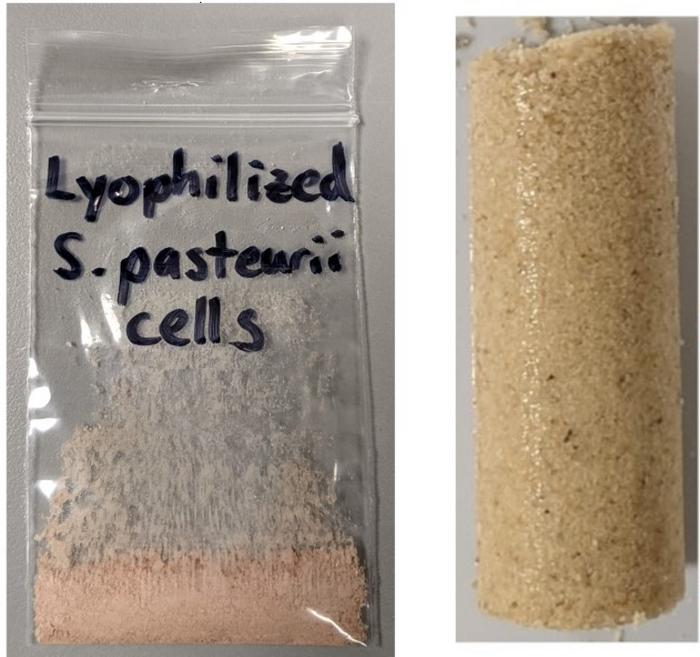In an innovative approach to construction materials, a team of researchers has successfully harnessed the capabilities of a specific bacterium, Sporosarcina pasteurii, to produce biocement—a sustainable concrete alternative. This advancement comes with the unveiling of a freeze-drying technique that allows for the preservation and easy application of these microorganisms. The implication of this research extends beyond just enhancing cement manufacturing; it broadens the horizons for how we can employ biological processes in civil engineering, potentially reshaping the industry to be more sustainable and efficient.
Cement production is notoriously carbon-intensive, accounting for a significant proportion of global greenhouse gas emissions. As the construction industry looks toward more sustainable practices, the introduction of biocement offers a promising avenue for reducing our carbon footprint. Sporosarcina pasteurii possesses the unique ability to convert urea—a nitrogen-rich compound—into calcium carbonate, effectively acting as a natural binding agent. The process not only stabilizes soil but can also repair cracks in existing concrete infrastructures. Thus, its application could presage a paradigm shift in how construction materials are conceived and utilized.
Current methodologies for utilizing Sporosarcina pasteurii necessitate the on-site cultivation of these microbes, which requires expensive and complex equipment, along with specialist knowledge. Recognizing these limitations, the research team, led by Maneesh Gupta, set out to create a method that allows these beneficial bacteria to be stored and transported in a shelf-stable form. This would ultimately enable construction professionals to deploy biocement solutions quickly and effectively without extensive prior knowledge or infrastructure.
In laboratory experiments, freeze-dried Sporosarcina pasteurii was mixed with sand in specially designed molds. When calcium chloride and urea were applied, the bacteria produced biocement, binding the sand particles together. Notably, the biocement structures created with commercial sandbox sand showed greater strength compared to those made with natural soil, indicating the importance of material selection in achieving desired outcomes. The researchers were able to demonstrate the efficacy of their method through controlled testing, which revealed that not only could the biocement adhere granular materials, but it could be scaled for larger field applications.
Field tests provided further validation for the team’s findings. By applying freeze-dried bacteria directly onto designated plots of land followed by the spraying of urea and calcium chloride, the results were promising. Within a mere 24-hour period, the top three inches of soil exhibited substantial increases in strength, effectively demonstrating the potential of this technology in real-world applications. This ease of use could mean major advancements in disaster-stricken areas where immediate structural stabilization is necessary.
Despite these accomplishments, the road ahead is not devoid of challenges. The researchers emphasize that ongoing studies are required to further explore the full potentials of freeze-dried Sporosarcina pasteurii. The implications of this research are vast, extending into various fields of construction and environmental management. With the continuous threat of climate change and the increasing need for sustainable practices, the relevance of biocement is underscored, representing a union between biology and technology in material science.
As civil engineers grapple with soil stabilization issues and the demand for durable construction materials, developments like this could lead to a greater reliance on biocement, paving the way for innovative solutions that meet the needs of modern infrastructure. The blending of microbial processes with civil engineering could redefine traditional approaches, turning waste into valuable building materials and fostering a cyclical economy within the construction sector.
In conclusion, the research behind the freeze-dried formulation of Sporosarcina pasteurii has unveiled an exciting new potential in biocement production, bridging the gap between nature and technology. The study not only advances our understanding of biogenic materials but also provides practical applications for enhancing construction efficacy and environmental sustainability. As this field progresses, we may witness the transformation of how we build, repair, and reinforce our infrastructures, ultimately leading to greener practices in the construction industry.
Subject of Research: Development of a shelf-stable formulation of Sporosarcina pasteurii for biocement production
Article Title: “Shelf-Stable Sporosarcina pasteurii Formulation for Scalable Laboratory and Field-Based Production of Biocement”
News Publication Date: 21-Jan-2025
Web References: http://dx.doi.org/10.1021/acsami.4c15381
References: Not provided
Image Credits: Credit: Adapted from ACS Applied Materials & Interfaces 2025, DOI: 10.1021/acsami.4c15381
Keywords
Biocement, Sporosarcina pasteurii, freeze-drying, sustainable construction, soil stabilization, calcium carbonate, microbial concrete, civil engineering, construction materials, environmental sustainability.
Tags: biocement productionbiological processes in civil engineeringcarbon-intensive cement alternativesfreeze-dried bacteria applicationsinnovative microbial techniques in constructionnatural binding agents in constructionreducing greenhouse gas emissionsrepairing concrete infrastructuresoil stabilization techniquesSporosarcina pasteurii in engineeringsustainable construction materials





